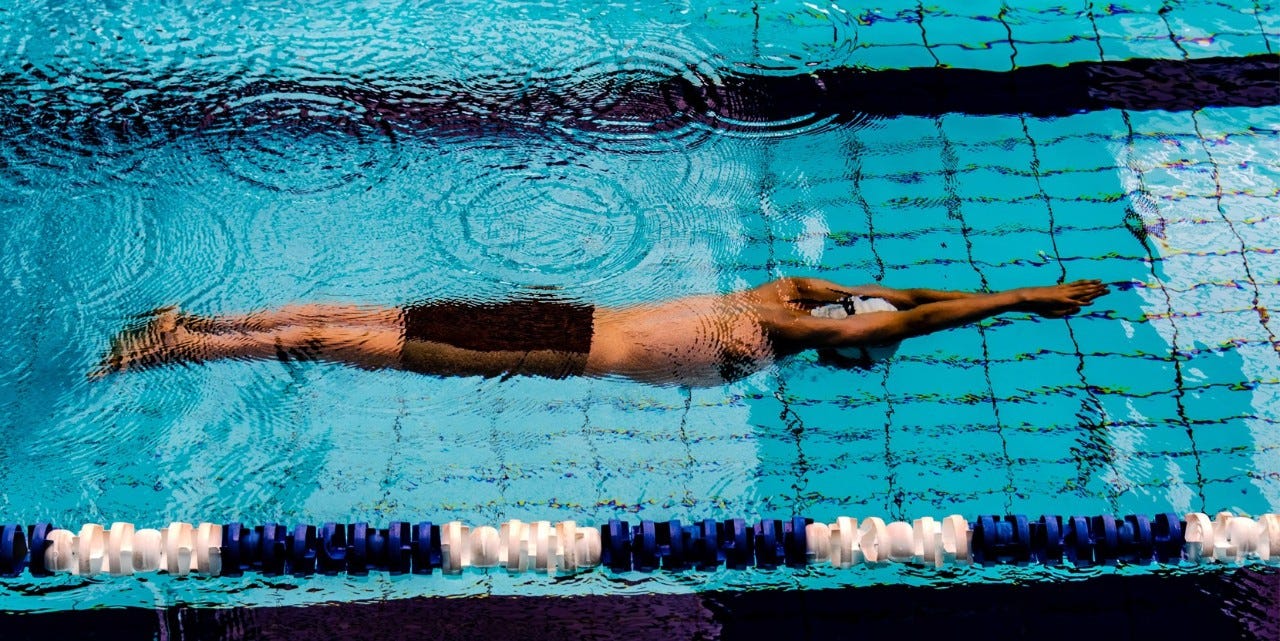10 swimming myths
We debunk some of the most common swimming myths. We debunk some myths about doing sport outside in winter.

Klettern die Temperaturen nach oben, gehört der Sprung ins kühle Nass für viele dazu. Genauso wie das Bier im Schlauchboot oder die Pommes in der Badi. Doch wie war das nochmal? Ist es nun gefährlich, überhitzt ins Wasser zu springen oder direkt nach dem Essen baden zu gehen? Und holt man sich einen Sonnenbrand unter Wasser – oder nicht?
1. Mit vollem Magen schwimmt man nicht.
Teils, teils. «Das ist eine der wohl bekanntesten Baderegeln. Aber leider auch eine, die so nicht ganz stimmt», sagt Philipp Binaghi von der Schweizerischen Lebensrettungs-Gesellschaft (SLRG). «Daher haben wir diese Regel vor Jahren angepasst. Wir betonen: Bitte nicht mit ganz vollem oder ganz leerem Magen schwimmen gehen. Wer gerade gegessen hat, macht sich auch nicht gleich an einen Marathon, und keiner kommt auf die Idee, einen 3000er ohne Frühstück erklimmen zu wollen.» Hier ist ein gesundes Mass wichtig: «Nach einem üppigen Essen fühlt man sich träge, da der Körper die Energie für die Verdauung braucht. Das Gehirn wird dann weniger durchblutet und dem Schwimmer könnte übel und schwindelig werden. Schlimmstenfalls wird man im Wasser ohnmächtig und ertrinkt lautlos.»Umgekehrt sollte man nicht mit komplett leerem Magen schwimmen, weil dies zu Unterzuckerung und einem Hungerast führen kann.
2. Nur Nichtschwimmer oder schlechte Schwimmer ertrinken.
Falsch! «Auch der besttrainierte Körper kann Schwächen und/oder Krämpfe erleiden», warnt Binaghi. Daher sollte man lange Strecken nicht alleine schwimmen. Wichtig sei zudem, sich selbst gut einschätzen zu können: «Bin ich fit? Ist das, was ich vorhabe, sicher und gut für mich? Entspricht es meinen Fähigkeiten? Wer sich selber kennt, gehört zu den guten Schwimmerinnen und Schwimmern und wird eine schöne Zeit im Wasser verbringen», ist sich der SLRG-Sprecher sicher. Von kühlem Bier, Weinschorle oder Aperol Spritz sollten Schwimmerinnen und Schwimmer die Finger lassen, denn wer Alkohol trinkt oder gar Drogen nimmt, überschätzt sich rasch einmal. «Ein Problem ist auch, dass Alkohol die Blutgefässe erweitert. Beim Schwimmen kühlt sich das Blut dann schnell ab und wandert aus Armen und Beinen über den Blutkreislauf in den Körperkern. Das erhöht die Gefahr eines Kreislaufkollapses.»
3. Nach dem Sprung ins kalte Nass droht der Herzinfarkt.
Höchst selten. «Diese Gefahr besteht zwar, wenn man überhitzt ins Wasser springt. Aber wirklich nur in den allerseltensten Fällen», weiss der Sprecher der Schweizerischen Lebensrettungs-Gesellschaft. «Da sich die Adern schlagartig verengen, kann das Blut nicht mehr richtig zirkulieren. Dies führt im schlimmsten Fall zu einem Kälteschock bis hin zur Ohnmacht oder tatsächlich zu einem Herzinfarkt.» Bemerkenswert ist allerdings, dass dies vor allem jüngeren Menschen passiert, deren Kreislauf agiler ist als der älterer Menschen.
Fest steht: Grosse Temperaturunterschiede sind für den Körper purer Stress, auf den er mit Muskelkrämpfen und Kreislaufproblemen reagieren kann. Daher sollte man sich vor dem Schwimmen kalt abduschen oder zumindest langsam ins Wasser gehen und dabei die Arme abwechselnd ins kühle Nass eintauchen und Gesicht und Oberkörper befeuchten.
4. Unter Wasser ist die Haut vor Sonnenbrand geschützt.
Falsch. Ganz im Gegenteil: Unter der Wasseroberfläche verstärkt sich die UV-Strahlung sogar. Laut dem Wissenschaftsmagazin «Quarks» dringen in einem halben Meter Tiefe noch etwa 40 Prozent der UV-Strahlung durch. Daher gilt: Auch beim Baden gehört der Sonnenschutz dazu!
5. Bei blauen Lippen sofort raus aus dem Wasser.
Richtig. «Bis die Lippen blau sind, sollte man aber nicht warten. Denn dies ist in der Regel ein Zeichen dafür, dass man ausgekühlt ist», sagt Binaghi. «Das ist nicht gut für den Körper, egal ob an Land oder im Wasser.» Schwimmer sollten sich dann erst einmal gut abtrocknen und aufwärmen.
Wichtig: Besonders Kinder kühlen schnell aus und verlieren im Wasser oft das Gefühl für Zeit und Temperaturen. Wenn Kinder zu zittern beginnen, ist es höchste Zeit für eine längere Planschpause.
6. Ertrinkende hört und sieht man vom Beckenrand oder Ufer aus.
Falsch. «Hollywood vermittelt gerne das Bild des wild schreienden und um sich schlagenden Ertrinkenden. Das stimmt aber nicht: Ertrinken ist ein stiller Tod», so die SLRG. In den meisten Fällen seien ertrinkende Menschen nicht dazu fähig, auf sich aufmerksam zu machen. Da sich der Mund beim Ertrinken unter der Wasseroberfläche befindet und nur kurzzeitig wieder aus dem Wasser auftaucht, ist die Zeit fürs Ausatmen, Einatmen und für einen Hilferuf zu kurz. Denn: Im Atmungssystem wird automatisch erst einmal die Atmung sichergestellt, bevor die Sprachfunktion eingreifen kann.
Auch Winken sei nicht möglich, da die Arme instinktiv seitlich ausgestreckt und von oben auf die Wasseroberfläche gedrückt würden. Diese Schutzfunktion soll den Körper über der Wasseroberfläche halten. Ertrinkende können die Arme also nicht mehr bewusst steuern. Binaghi betont: «Während des Ertrinkens befindet sich der Körper aufrecht im Wasser. In der Regel können sich Ertrinkende nur 20 bis 60 Sekunden an der Wasseroberfläche halten, bevor sie untergehen. Das bedeutet, es bleibt wenig Zeit für den Rettungsschwimmer.»
Aber: Selbstverständlich kann sich auch eine Person, die schreiend und winkend um Hilfe ruft, in einer ernsthaften Situation befinden. «Anders als beim tatsächlichen Ertrinken, können sich diese Menschen an ihrer eigenen Rettung beteiligen und in der Not nach Rettungsleinen oder -ringen greifen.»
7. Keine Sorge: Im Meer ist es am gefährlichsten.
Falsch! «Die Gefahr geht grundsätzlich von der jeweiligen Person und ihrem Verhalten am und im Wasser aus. Es gibt zwar Umwelteinflüsse, darunter auch die Gewässerart, die eine Auswirkung auf das Risikopotenzial haben können. Aber letzten Endes ist die Person dafür verantwortlich, welche Risiken sie eingeht und welche nicht», weiss der Rettungsschwimmer. Will heissen: Es gibt Gefahren in allen Gewässern. Entscheidend ist aber der Umgang mit diesen.
Übrigens: In der Schweiz kommen am meisten Menschen in Seen ums Leben (2019: 24), dicht gefolgt von Flüssen (2019: 23). In Badis ertrinken verhältnismässig wenige Menschen (2019: 1).
8. Nasse Badekleidung führt zu einer Blasenentzündung
Richtig. Gerade im Sommer haben Bakterien leichtes Spiel: Wer lange im nassen Badekleid fröstelt oder auf den kalten Steinfliessen am Beckenrand sitzt, kann sich eine unangenehme Blasenentzündung einfangen: Wenn der Unterleib auskühlt, verengen sich die Blutgefässe und die Durchblutung der Schleimhäute reduziert sich. Dies begünstigt Infektionen. Aus diesem Grund sollte man nach dem Schwimmen gleich trockene Kleidung anziehen.
9. Wer Wasser aus dem Becken schluckt, bekommt Durchfall.
Jein. Gestern in der Badi, heute mit Durchfall im Bett? Obwohl Chemikalien wie Chlor und Filteranlagen Keime in Schach halten und die Wasserqualität streng überwacht wird, ist eine Infektionsgefahr gegeben. Daher kommt es immer wieder vor, dass sich Badegäste den Magen verderben oder eine Ohren-/Augenentzündung holen. Ein erhöhtes Risiko besteht vor allem dann, wenn das Wasser seicht und warm ist, wie an Seeufern oder in Planschbecken. Daher sollten vor allem Kinder und Babys möglichst kein Wasser schlucken.
10. Als Schwangere sollte man nicht schwimmen gehen.
Falsch. Schwimmen in der Schwangerschaft erfrischt, hält fit und ist ein schonender Sport. Deshalb ist er für Schwangere sehr zu empfehlen, gerade in den späteren Monaten, wenn die Beweglichkeit nachlässt und das Gewicht steigt. Wichtig ist dabei, dass die werdende Mutter sich nicht überanstrengt. Aus hygienischen Gründen sollte sie auf entspannende Bäder in Whirlpools verzichten, da das Wasser oft lange nicht gewechselt wird. Schwangere reagieren aufgrund des veränderten Scheidenmilieus schnell mit vaginalen Infektionen.


